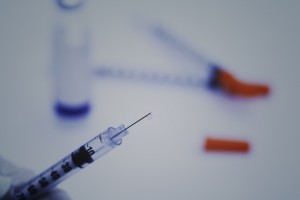 Three presentations during the “Melanoma and Other Skin Tumors” poster session at the European Society for Medical Oncology (ESMO) 2014 Congress in Madrid highlighted the efficacy of treating cutaneous melanoma with intralesional injections. By injecting treatment directly into tumors, clinicians were able to evoke tumor regression of both the injected tumor and other lesions.
Three presentations during the “Melanoma and Other Skin Tumors” poster session at the European Society for Medical Oncology (ESMO) 2014 Congress in Madrid highlighted the efficacy of treating cutaneous melanoma with intralesional injections. By injecting treatment directly into tumors, clinicians were able to evoke tumor regression of both the injected tumor and other lesions.
“We’re likely to get the highest responses when all lesions are injected,” stated Sanjiv Agarwala, first author on the poster from St. Luke’s Hospital, in a news article from ECancer News. Agarwala’s poster highlighted the use of intralesional PV-10 during the ongoing phase 2 clinical trial of patients with stage IIIB-IV melanoma. PV-10 is thought to cause catastrophic cell death within injected tumors and enhance the immune response to augment systemic defenses against tumors.
Agarwala reported that PV-10 is more effective than the current dacarbazine (DTIC) and temozolomide (TMZ) treatments for melanoma. “The progression free survival of 9.8 months [for the 28 PV-10-injected patients] compares favorably with historical progression free survivals of less than 2.5 months for DTIC/TMZ,” said Agarwala.
The positive effect required only a few injections, which is important for patient compliance. Of the 232 responding lesions injected in the study, 121 needed only one injection, 84 needed only two, 22 needed three, and five needed four to be effective. “The few injections needed in this study bode well for patient compliance with PV-10 treatment,” said Eric Wachter, Chief Technology Officer of Provectus, which developed PV-10.
Another poster presented at the Congress focused on an extension of the phase 3 OPTiM study for Talimogene laherparepvec (T-VEC) injections in patients with unresected stage IIIB-IV melanoma. Patients included in the study had either experienced a complete response and developed a new tumor a year after treatment or showed no clinically relevant signs of progressive disease.
“We were able to show that in some patients whose disease had returned we could get them back into remission by re-challenging them with the agent,” said Kevin Harrington, author of the study at the Institute of Cancer Research in London. “We also showed that T-VEC was very tolerable with no additional toxicity burdens for reinjection.” Seven of the 28 patients in the T-VEC arm of the study showed a complete response.
Finally, a poster receiving “best poster award” investigated Coxsackievirus (CVA) A21 intralesional injections in the phase 2 CALM study. Twenty-two of the 57 patients with stage IIIC and IV melanomas achieved immune-related progression free survival after six months of treatment, the primary endpoint. Another 28.1% achieved an irRECIST-defined complete partial response, the secondary endpoint.
With these poster presentations comes new progress within the field of melanoma treatment. Locoregional therapies including surgery and radiation are not sufficient for locally advanced melanomas at high risk for recurrence, progression, and metastasis, and intralesional injections may provide a solution.


